Maybe your old house had its details stripped away and they remain unknown, but you need to install a mantel or trim. Maybe you want to decorate with an eye to period style but choices overwhelm you. How do you design a bookcase, a room, or a wing that looks like it belongs? Sensitive designers find a precedent, not necessarily to produce a replica, but as a starting point. Cues come from the house itself; its entry door, staircase, or fireplace may offer a vocabulary to use so that new work “speaks the same language.”

INSPIRATION #1 A set of Stickley chairs inspired the wood cladding design for a bar counter. (Photo: Bruce T. Martin Photography)
Look in the neighborhood, or to other houses by the same builder or architect, and you may find an original butler’s pantry on which to base your kitchen cabinets. Finally, study the good work of your house’s period.
INSPIRATION #1 Period Furniture
Today’s owner of a former tenement apartment needed a bookcase and a wardrobe in the exceedingly small space. Inspiration for a tiny oak library done up in full English Aesthetic Movement regalia came from the furniture of famed Modern Gothic cabinetmakers Kimbel & Cabus. A dropleaf desk suggested the design of ornate hinges and incising; a corner cabinet inspired the use of inset art tiles (reproduced from one antique tile by Pugin). Carved capitals and lancet finials are based on other Kimbel & Cabus pieces. The shingled roof comes from a Pottier & Stymus bookcase. It lifts up to reveal storage space.
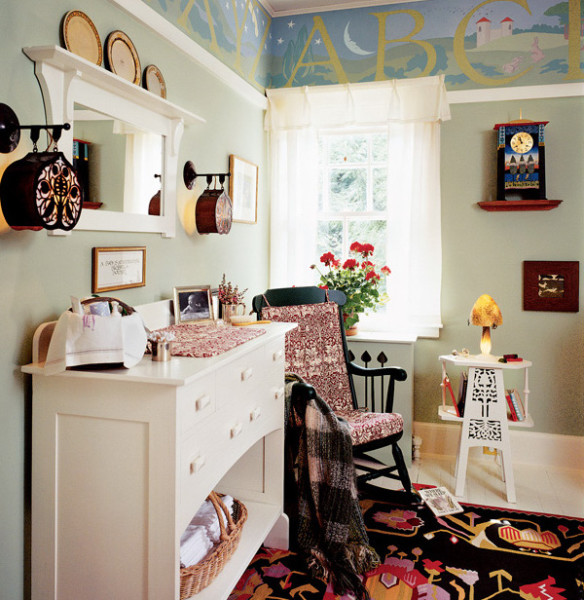
ILLUSTRATION #2 Two precedents were adapted for the nursery: the little table from a Liberty’s of London catalog, and the alphabet frieze from a 1901 illustration. (Photo: Sam Gray)
INSPIRATION #2 ArchivalSources
Print sources lent ideas for a lovely nursery combining English and American Arts & Crafts elements. Precedent for the alphabet frieze came from a 1901 watercolor by the American artist and designer Will H. Bradley, published in The Ladies’ Home Journal. A little table depicted in the ca. 1899 Liberty’s of London catalog was the model for the stenciled reproduction. The dresser and mirror are copies of pieces sold by the L. and J.G. Stickley Co. around 1905. The example below is even more direct: the newly built sideboard for an Arts & Crafts-era dining room was modeled on
one in a period millworks catalog.
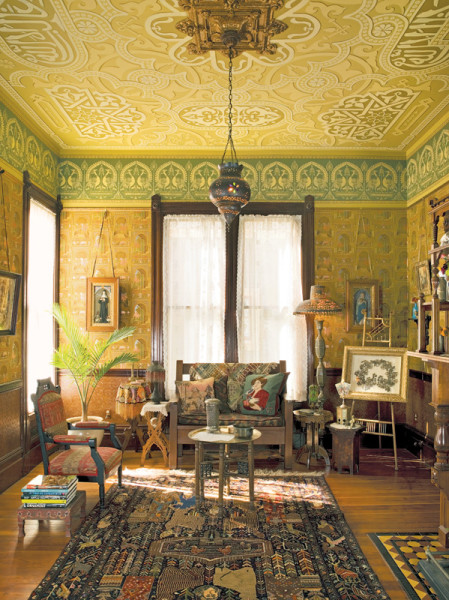
INSPIRATION #3 Stenciling or otherwise hand-painting decoration allows for scaling historical patterns and choosing any palette. (Photo: David Duncan Livingston)
INSPIRATION #3 Decorating History
After buying an 1887 Eastlake-style house in Alameda, the homeowner studied such Victorian designers as Christopher Dresser, hoping to stay true to the period during her restoration efforts. Choosing stencils over revival wallpapers started out as a budget measure. The owner became a devoted student of late Victorian design, and her skills grew. Soon she was creating one-of-a-kind decorating fantasies—adapting motifs from design history, drawing the stencils, hand-cutting them, and applying the paint.
This is her interpretation of an exotic 19th century Moorish-themed parlor. The ceiling design is based on a plate from Owen Jones’s 1851 The Grammar of Ornament—which is still in print. The design originated from the Alhambra’s Court of Lions. ‘The Alhambra’ wallpaper is from Burt Wallpapers (burtwallpapers.com). The stenciled peacock frieze comes from an Indian fabric design.
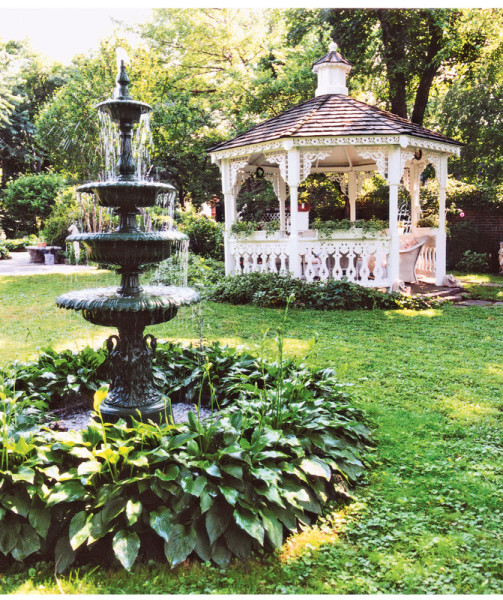
INSPIRATION #4 As the new gazebo was being constructed, the homeowner came across old balusters that show up in a 1910 photo of her house. Their sawn design was copied for the gazebo rail. (Courtesy: Marion Duckworth Smith)
INSPIRATION #4 Memories, or an Old Photograph Found
Your design muse may be memory of a long-ago room. In place of a bad 1970s remodeling, one woman re-created her beloved grandma’s 1930s kitchen. Design started with a countertop of small white hexagon tiles and the black bullnose trim of the period. It was easy to conjure up the yellow-vanilla paint and cabinets filled with Fiesta dinnerware.
In another example, homeowners were building a Victorian-style gazebo on the property of their early Dutch homestead. In the attic they discovered a pile of sawn balusters, and recognized them from a 1910 photo: the balustrade had been on the old house during the Victorian era! The builder made a pattern and replicated balusters for the gazebo: design problem solved and a bit of history saved.
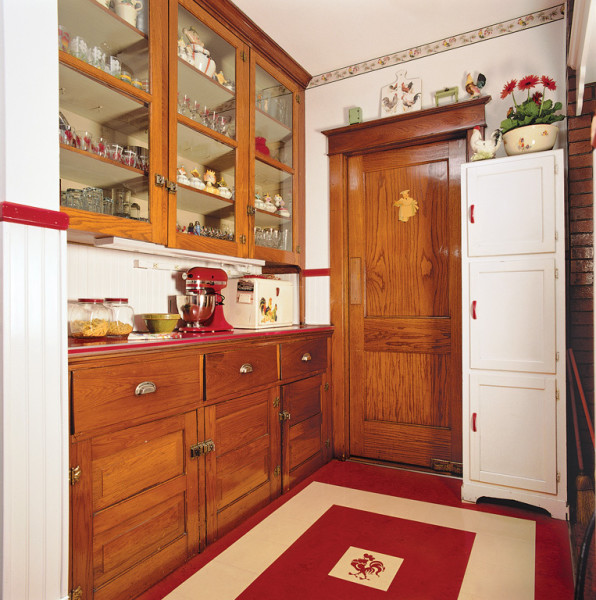
INSPIRATION #5 An iconic 1940s rooster-motif drinking glass was set to inspire the room’s color and design. (Photo: Gross & Daley)
INSPIRATION #5 An Object or Motif
Sometimes it’s fun to riff on a favorite theme. The owner of a 1926 house has a vast collection of red-and-white, mid-century kitchenware. Once the decision was made to create a Forties kitchen, reversing a bad later remodeling, an iconic 1940s rooster-motif drinking glass was set to inspire the room’s color and design. The motif even helped create a unique floor. Marmoleum sheet flooring was water jet-cut into 9″ squares, typical of mid-century linoleum. The facility also cut the rooster design and inlaid it into six of the cream-color squares. With no on-site inlay to master, the owners were able to lay the floor themselves, making it a budget-friendly project. The rooster motif is seen here in the pantry connected to the new kitchen.
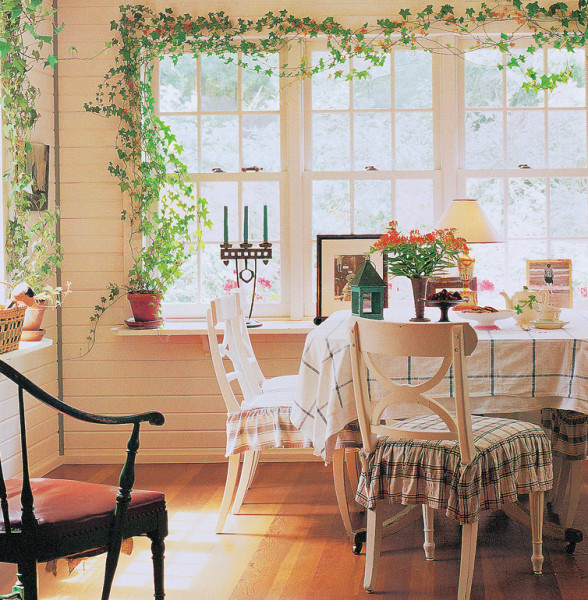
INSPIRATION #6 Find inspiration at a house museum, or in a book about historic homes. (Courtesy: Chronicle Books)
INSPIRATION #6 A Historic House
Find inspiration at a house museum, or in a book about historic homes. The recently remade dining room was clearly modeled on the drawing room at the home of Swedish artists Carl and Karin Larsson—itself a ca. 1900 interpretation of 18th-century late Gustavian decoration.
The beadboard-clad island with rounded corners was inspired by an eccentric sink cabinet built by a ship’s carpenter, which the homeowner remembered from a visit to Castle Tucker in Wiscasset, Maine.







